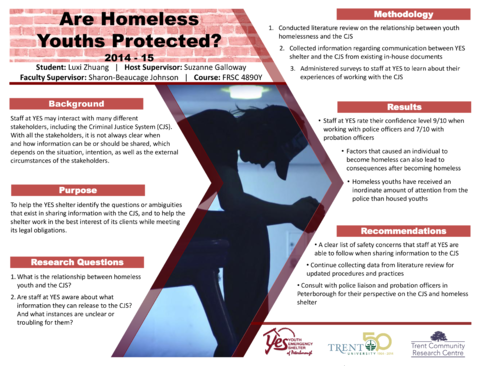YES Shelter for Youth and Families
YES Shelter for Youth and Families: Communication Protocols Part 1 [poster]
YES Shelter for Youth and Families: Communication Protocols Part 1
The purpose of the present project was to help the staff of the YES Shelter for Youth and Families to understand when their clients' personal information is required to be shared with others, primarily those in law enforcement. To fulfil the purpose, legislation surrounding the sharing of personal information was researched, along with other homeless shelters. Privacy policies of homeless shelters similar to the YES Shelter were obtained through email and telephone interviews. Research from the legislation allows for the personal information of clients to be shared with the police when the information is used to help an investigation and to protect the life and health of a person. With the exception of one shelter, all the shelters that shared policies lack privacy policies. However, all the shelters do not permit the sharing of client information to those outside of law enforcement. Eva's Initiatives was the only shelter to have detailed privacy policies, which allow for the disclosure of client information to those in law enforcement when the information is used to protect the life and health of a person. The research gathered from the present project is being used by the YES Shelter to create privacy policies for their staff.
YES Shelter for Youth and Families: Communication Protocols Part 2 [poster]
YES Shelter for Youth and Families: Communication Protocols Part 2
The aim of the present project was to identify the questions or ambiguities that concern the staff members of the YES Shelter for Youth and Families regarding the sharing of personal information of youth clients with law enforcement agencies. To accomplish this, the relationship between homeless youth and the criminal justice system was initially researched through journal articles within the past five years to determine why homelessness can lead to criminal behaviour and why homeless youth potentially receive more attention from police. Current policies and procedures from the YES Shelter were also reviewed for ambiguities when sharing information with law enforcement. Survey question were administered to YES staff regarding the release of client information when communicating with police and probation officers. Research through a literature review identified numerous factors leading to homeless youth becoming involved in criminality, such as drug use. In addition, homeless youth often receive extensive attention from police whether they are criminally involved or not, because they are often socially profiled as "dangerous" by the public. Survey responses from YES staff showed a high and consistent level of confidence when releasing client information to the police; however the confidence level when sharing client information with probation officers was low and inconsistent. Overall, youth clients at the YES Shelter felt that their privacy was secured and protected. The research gathered from the present project aims to help the YES Shelter create privacy policies for their staff. Lastly, a list of recommendations was suggested for future research.



